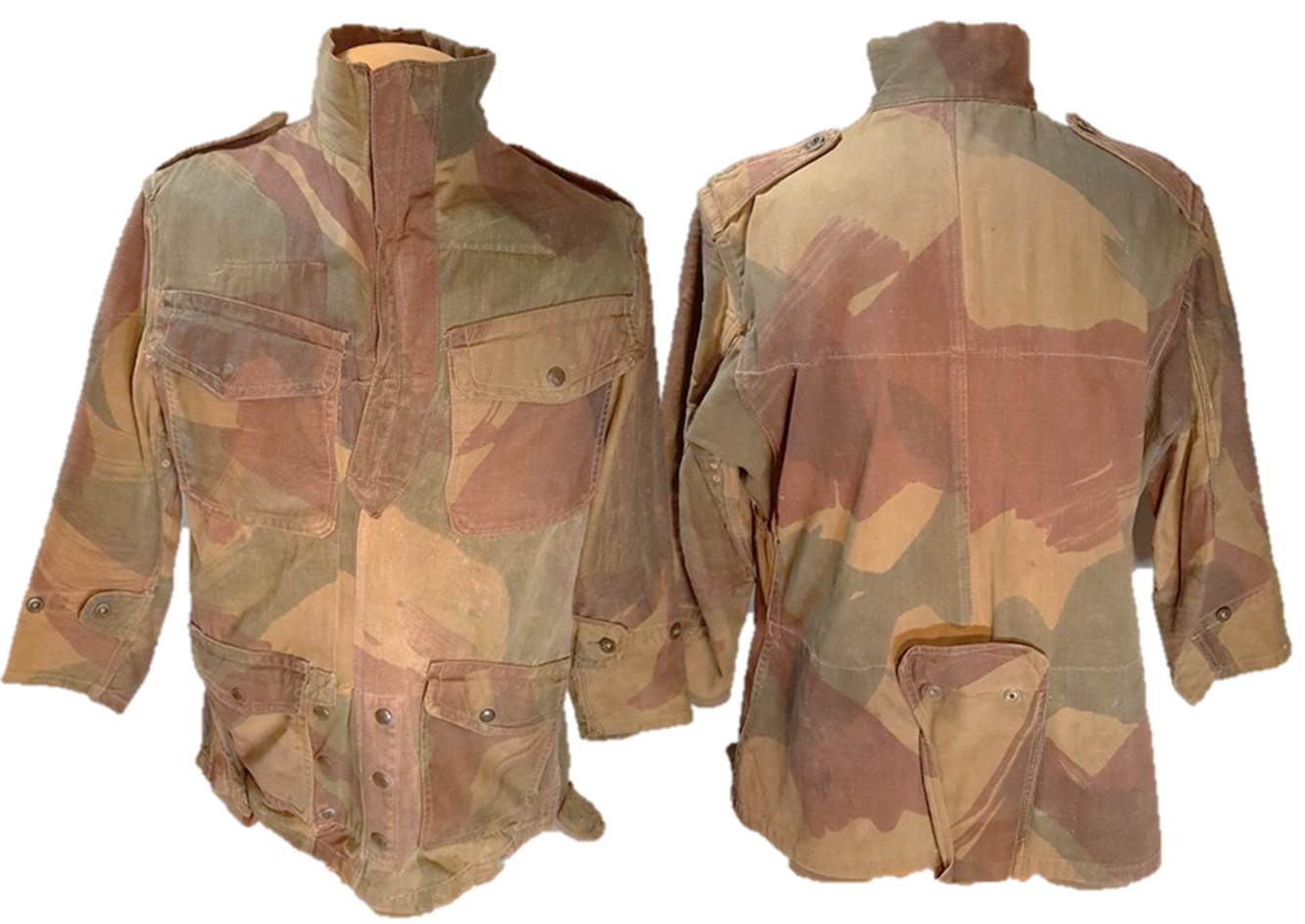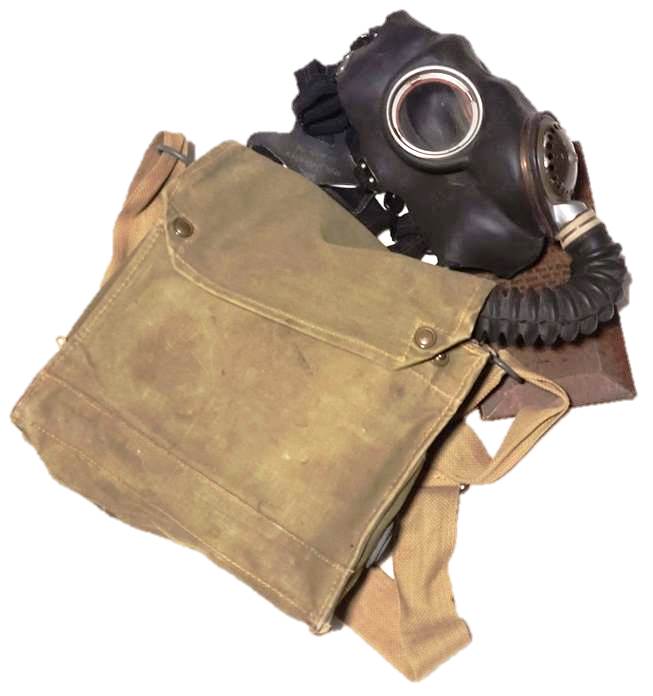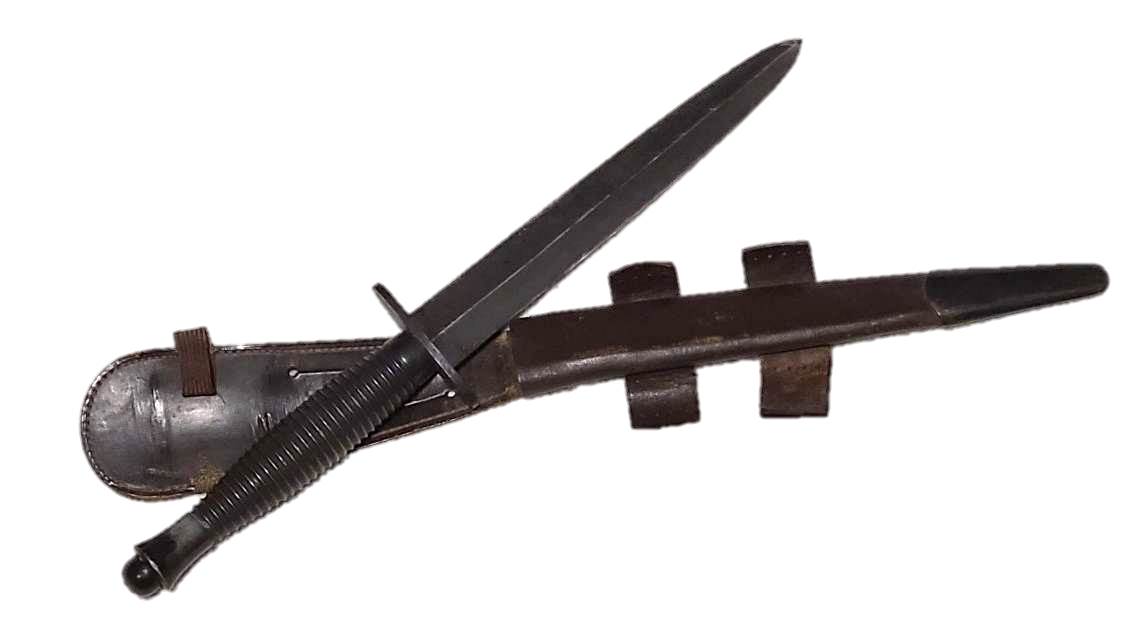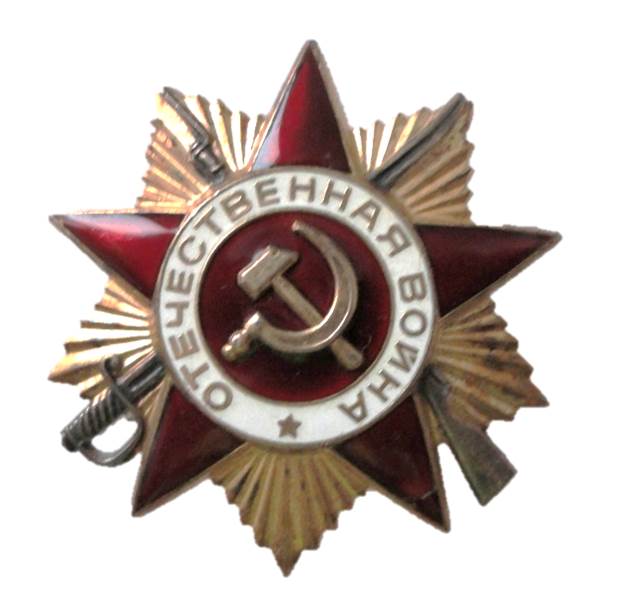


Cap badge worn on berets of soldiers guarding the Maginot Line.

Aluminum coins issued under the Vichy government.

French commemorative medallion issued in honor of Winston Churchill and the British soldiers who liberated France in WWII.


The Distinguished Service Order medal, dated 1945.

Battledress uniform jacket (1940 pattern) worn by a Polish soldier who fought in the British Army. These Polish soldiers fought in the British army, perhaps most famously in the Italian Campaign at Monte Cassino.


1940 pattern Battledress with cap and patches to the deceptive unit, "R Force." This small unit worked to make it appear the Allied forces were larger than they were, and deceive enemy intelligence. This veteran was part of the Royal Electrical and Mechanical Engineers and has the patch for a wireless operator.

A selection of British shoulder insignia. Similar to the US army, patches were used for individual units in the British military.

Assorted British regimental insignia. Similar to the US Distinctive Unit Insignia, each regiment had its own crest. These were worn on collars.

Royal Air Force and Royal Australian Air Force cloth insignia.


Two British medals from WWII. The 1939-1945 Star at left bears a scarce "Battle of Britain" bar. The Africa Star at right was awarded to troops serving in Africa during WWII.

Beret worn by Royal Air Force pilots who transported troops for airborne invasions. The maroon beret was famously worn by airborne troops.

Shoulder patch of the 1st Special Air Service, a Special Forces group formed in 1941.

British airborne helmet. These were worn by parachutists, most famously at D-Day and Market Garden.

Cap worn by a veteran of the Argyll & Sutherland Highlanders of Canada.

British WWII web belt. Similar to the US model, it could support a pack and various gear items.

British spike bayonets for the No.4 Enfield rifle (1944-1945).

1944-dated British leggings

Battledress uniform jacket (1937 pattern) worn by a member of the British commandos. The No. 9 Commando was created in 1940 and served with distinction in France Italy, and North Africa.

1940 pattern Battledress trousers.

Royal Canadian Air Force "Wireless Aerial Gunner" wing.

British Mk.II steel helmet. This particular model was produced in Canada in 1941 and is equipped with a two-tone net for camouflage.

The Mk.III steel helmet. This was produced in 1944 and famously used by Commonwealth forces at D-Day. It improved on the earlier Mk. II with greater depth for head and neck protection.

Royal Canadian Air Force "wedge cap" worn by airmen.

British canteen and strap. While American canteens were usually affixed to a belt, Commonwealth ones were carried slung on a strap.

A basic British soldier's gear setup. This includes two large ammunition pouches, a belt, and shoulder straps.

Canadian-made holster for the Webley pistol

Airborne shoulder flashes and parachute qualification badge.

Commando shoulder title.

Airborne patch and sewn tab

Large pack for British soldiers. It would contain spare uniforms, equipment, and personal items.

British 1907 pattern bayonet, used with the British Enfield rifle.

British Enfield No.4 rifle, used 1941-1945.

Sten MkII submachinegun. This 9mm weapon was mass produced cheaply out of stamped parts. Over two million of this version alone were produced--while it equipped military forces, it was also dropped in large numbers to equip resistance forces.

A British paratrooper's jacket, known as the Denison smock. Developed in 1942, it was intended to be worn over one's gear while parachuting, and often as an outer garment in the field. It was fitted with a "beaver tail" that secured the jacket between the legs. This is an example of the second pattern with a half zip and without knit cuffs; while its tag is mostly washed out, a War Department stamped code indicates acceptance in 1945.


Group of wings, ribbons, cap, and gloves from a Royal Canadian Air Force pilot who flew Halifax bombers over Europe. He was awarded the Distinguished Flying Cross.

1943-dated beret as worn by the Tank Corps.

Cap badge of the Royal Tank Corps.

Blazer jacket patch of the Canadian Parachute Corps. Canadian paras landed on D-Day and jumped into Germany as well.


1942-dated covers for the Enfield rifle.

Very rare patches for the Allied Forces in Norway, worn late 1944-1945.

Excellent example of a Fleet Air Arm pilot's wing. The FAA was the air section of the British forces at sea.

Patch of the Canadian Women's Army Corps. Formed in 1941, it enlisted women into the army in a wide variety of roles.

British wound dressing, as carried by all Commonwealth soldiers.

The experimental Mk.7 bayonet for the No. 4 Enfield rifle. It was developed at the end of WWII. It served both as a bayonet and fighting knife but did not last long in service.

A Nepalese kukri knife, dating from the turn of the century. These iconic knives were carried by the Ghurkas that served with fame in WWI and WWII.

Uniform badge worn by Canadian soldiers to show their country of origin.

1941-dated British gas mask.

3rd pattern Fairbairn-Sykes commando dagger. These were issued to airborne and commando troops.

Australian MkIII helmet. Very similar to the British-made MkII, this features a sturdy rubberized canvas liner and a raw edge.

Grouping of unattributed medals from a veteran of African and Italian campaigns with the British 8th Army.

Royal Canadian Air Force jacket. This Flight Lieutenant earned his wings in 1940, served in the Battle of Britain, and trained pilots from 1944. He was awarded the Air Force Cross in 1944.

Unattributed RCAF uniform from a Squadron Leader. Awards include the Distinguished Flying Cross.

1943-dated ammunition boots

WWII-early postwar Canadian jump wings


Polish WZ24 bayonet for the Mauser rifle. Large number of these, including this one, were captured by the Germans early in WWII and reissued to the Wehrmacht. This one was given a German ersatz bayonet frog and German markings on the scabbard.

Polish cavalry helmet from 1939.

Monte Cassino Cross, awarded to Polish soldiers who fought at the Battle of Monte Cassino, Italy. This particular medal was awarded to a rifleman of the 5th Kresowa Infantry Division who later immigrated to the US and lived in Chicago. Each cross was numbered and assigned to a veteran; just under 50,000 were authorized and awarded.

Polish Air Force badge (top), and a handmade Polish Army emblem. Oral history with the lower badge states that it was made by a civilian during the German invasion of Poland in 1939 and given to a soldier, who kept it throughout the war.

Patch for Polish soldiers fighting "in exile" for Great Britain. Polish soldiers famously served in Italy and the Middle East.

Badge of the 5th Kresowa Infantry Division, a Polish unit of the 2nd Corps of the British Army. Organized in 1943, the 5th fought on the Italian Front and with valor at Monte Cassino.

II Corps pocket badge

Polish paratrooper wings. This is a non-regulation example, possibly made in Britain.


Order of the Red Star, awarded for bravery.

Order of the Great Patriotic War, First Class. These were awarded to participants in World War II.
Mosin Nagant rifles used by Soviet soldiers in WWII. The shorter "carbine" version was used by tank crews and cavalry. These were 5-round bolt-action rifles that were first introduced in the late 1800s and used from WWI up to the early 1950s.

Russian Nagant revolver and ammunition. It is dated 1936 and the holster is a postwar example.

SSH-39 steel helmet, developed right at the onset of WWII. This example has remnants of black paint, indicating possible naval/marine use. The liner is a scarce canvas variation.